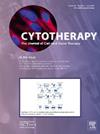us2介导的免疫逃避:产生低免疫原性iPSC系的新策略
IF 3.2
3区 医学
Q2 BIOTECHNOLOGY & APPLIED MICROBIOLOGY
引用次数: 0
摘要
背景,供体和受体之间HLA单倍型的不匹配显著增加由于免疫排斥而导致移植失败的风险。虽然敲除β -2微球蛋白(B2M)是目前防止HLA I类表面表达和保护干细胞衍生产物免受同种异体排斥反应的标准,但完全去除HLA- 1分子会损害自然杀伤细胞(NK)的“自我”识别并破坏关键的免疫调节相互作用。为了解决这些挑战,我们通过将巨细胞病毒衍生的US2编码序列插入AAVS1安全港位点,开发了一种新的低免疫原性诱导多能干细胞(iPSC)系。对修饰细胞的转录组学分析证实,US2的表达保留了内皮细胞(ECs)和肾类器官的干细胞性和分化能力。结果流式细胞术(FACS)分析显示,us2的表达消除了HLA- a2细胞表面的表达,同时保留了低水平的非经典HLA分子。在共培养实验中,与B2M KO ECs相比,US2的表达消除了HLA-A2同种异体反应性T细胞的激活,并显著降低了NK细胞的激活和脱颗粒,表明US2具有更好的逃避“缺失自我”介导的NK细胞反应的能力。这些研究结果表明,us2介导的“隐形”技术是B2M基因敲除的一种完善的替代方法,可以选择性地调节HLA表达以减轻免疫排斥反应,同时保留关键的免疫调节相互作用。本文章由计算机程序翻译,如有差异,请以英文原文为准。
US2-mediated Immune Evasion: A Novel Strategy For Generating Hypoimmunogenic iPSC Lines
Background & Aim
Mismatches in HLA haplotypes between donors and recipients significantly increase the risk of graft failure due to immune rejection. While knocking out beta-2 microglobulin (B2M) is the current standard for preventing HLA class I surface expression and protecting stem cell-derived products from allogeneic rejection, the complete ablation of HLA-I molecules can impair natural killer (NK) cell “self” recognition and disrupt critical immune-regulatory interactions.
Methodology
To address these challenges, we developed a novel hypoimmunogenic induced pluripotent stem cell (iPSC) line by inserting the cytomegalovirus-derived US2 encoding sequence into the AAVS1 safe harbor locus. Transcriptomic analysis of the modified cells, confirmed that US2 expression preserves stemness and differentiation capacity into both endothelial cells (ECs) and kidney organoids.
Results
Flow cytometry (FACS) analysis revealed that US2-expression abrogates HLA-A2 cell surface expression while retaining low levels of non-classical HLA molecules. In co-culture assays, US2 expression abolishes HLA-A2 alloreactive T cell activation and significantly lowers NK cell activation and degranulation compared to B2M KO ECs, demonstrating superior evasion of "missing self"-mediated NK cell responses.
Conclusion
These findings establish US2-mediated "stealth" technology as a refined alternative to B2M knockout, offering selective modulation of HLA expression to mitigate immune rejection while preserving critical immune-regulatory interactions.
求助全文
通过发布文献求助,成功后即可免费获取论文全文。
去求助
来源期刊

Cytotherapy
医学-生物工程与应用微生物
CiteScore
6.30
自引率
4.40%
发文量
683
审稿时长
49 days
期刊介绍:
The journal brings readers the latest developments in the fast moving field of cellular therapy in man. This includes cell therapy for cancer, immune disorders, inherited diseases, tissue repair and regenerative medicine. The journal covers the science, translational development and treatment with variety of cell types including hematopoietic stem cells, immune cells (dendritic cells, NK, cells, T cells, antigen presenting cells) mesenchymal stromal cells, adipose cells, nerve, muscle, vascular and endothelial cells, and induced pluripotential stem cells. We also welcome manuscripts on subcellular derivatives such as exosomes. A specific focus is on translational research that brings cell therapy to the clinic. Cytotherapy publishes original papers, reviews, position papers editorials, commentaries and letters to the editor. We welcome "Protocols in Cytotherapy" bringing standard operating procedure for production specific cell types for clinical use within the reach of the readership.
 求助内容:
求助内容: 应助结果提醒方式:
应助结果提醒方式:


